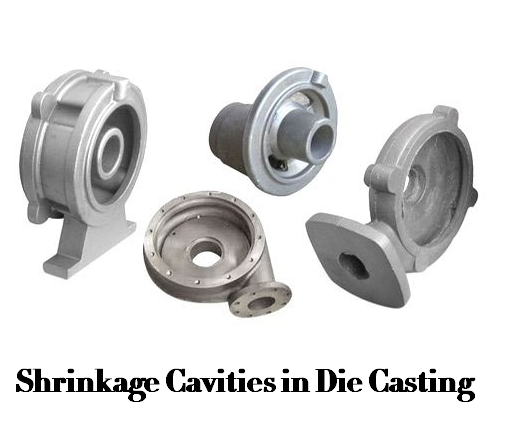Causes and Solutions of Shrinkage Cavities in Aluminum Die Casting - What is Shrinkage Cavity | Diecasting-mould
The shrinkage cavity is a common internal defect that possibly appears on aluminum die casting parts, it is often found in the position where the product wall thickness is large or hot spots are easy to form. In some cases, shrinkage defects will affect the use of casting products seriously. So it’s necessary to find the causes and solutions of die casting shrinkage cavities.

What is Shrinkage Cavity?
Shrinkage cavity refers to the void defects caused by shrinkage during the die casting process, if the cavities are not dealt with, holes will be formed after the castings are produced. Generally speaking, as long as the shrinkage cavity does not affect the performance of the part, the product is also judged as qualified. But, for some important parts such as the lubricating oil passage hole of cylinder blocks of automobile engines, the shrinkage cavities are not allowed. Because if there are shrinkage cavities near the passage hole, the lubrication effect will be affected seriously.
Causes of Shrinkage Cavities in Aluminum Die Casting
The shrinkage cavity often occurs on sharp corners of the mold, thick wall area of the product, and areas with great mold temperature differences. Based on the formation mechanism of shrinkage in aluminum die casting, let’s explore the causes of die casting shrinkage cavities and how to solve the problem. There are many reasons for shrinkage cavities of aluminum die casting parts, the root cause is the unreasonable structural characteristics of the die casting system, including gating system, cooling system, and process parameters. This causes insufficient aluminum liquid feeding during the transformation of aluminum alloy from liquid to solid. Check out the common causes of aluminum die casting shrinkage.
1. The temperature gradient of die is unreasonable, which leads to the local shrinkage of molten aluminum inconsistent.
2. The mold has a hot junction or sharp areas.
3. In the pouring process, the amount of the molten material is too small, resulting in insufficient pressure supplementation during the pressurization stage and thin molten material.
4. The die casting pressure is set too low and the feeding effect is poor.
5. The width of the gate in the die is not enough and the area is small, which leads to premature solidification of die casting. The pressure transfer in the pressurization stage is blocked, resulting in molten aluminum being fed.
Solutions and Measures of Shrinkage in Aluminum Die Casting
1. Ensure reasonable die casting pressure and thickness of the molten metal
Only molten materials with proper thickness and appropriate die casting pressure can form a die casting part with a dense internal structure, so low die casting pressure and thin molten material may cause shrinkage cavity, we can increase the pressure and thickness of the molten material properly. This improvement is mainly aimed at the shrinkage cavity of die castings in the early stage.
2. Control the mold temperature
The critical reason that causes shrinkage of die castings is insufficient molten material feeding during the solidification stage and uneven temperature distribution of mold temperature. When the molten aluminum solidifies, the molten aluminum inside the die casting with a great wall thickness is still in the liquid phase or the solid-liquid mixed phase due to the high temperature, and at this time the passage for feeding the inner gate may have solidified. In this way, during the pressurization stage, the die casting cannot be fed with molten aluminum, which may cause shrinkage cavities. So to control the reasonable mold temperature at a reasonable level is significant. In order to reduce the mold temperature at the shrinkage cavity part, some measures can be taken, such as improve the mold cooling system, reduce the pouring temperature and extend the spraying time of the shrinkage cavity part. This countermeasure is mainly used to control the midterm shrinkage.
3. Secondary pressurization
The measures applied in the first two stages can basically ensure the die casting mold in a theoretically reasonable state, but the shrinkage of die castings can’t be completely solved. Because the great wall thickness may cause insufficient feeding, and after the pressurization, this area has not completely solidified and continues to shrink and produces a shrinkage cavity. Generally speaking, the feeding of die castings is carried out through the path from molten materials to runners, inner gates and the die casting at last. Since the thick part of the die casting solidifies at the inner gate, the feeding passage in the late stage of pressurization is cut off, resulting in feeding being stopped. So, add a structure near the shrinkage cavity part of the die casting to act as the molten material, and use a pair of cylinder core pulling mechanism as the punch to secondly pressurize and feed areas which are prone to shrinkage cavities, in order to achieve the purpose of eliminating shrinkage cavities. Generally speaking, such a secondary pressurizing mechanism is called an extrusion pin, and its pressurizing principle is to apply appropriate pressure after the molten metal or molten alloy is poured and before the molten metal is completely solidified to enhance feeding.
4. Attach a sprue to the thick section of the mold
Due to the shrinkage cavities often occurs on the mold where the wall is thick, in the heavy sections of the mold, the metal takes longer to contract and solidify, which reduces feed material availability and increases the likelihood of shrinkage. So a properly sized sprue attached to the heavy section can fill the shrinkage cavity and provide the feed material necessary to counteract shrinkage as cooling occurs. A larger central sprue is better than flat, square, or narrow ones, it can help achieve an even supply of material.

